
In today's competitive business landscape, simply having a great product or service is not enough to guarantee success. To stand out from the crowd and drive sustainable growth, businesses need a strategic business development plan. This blueprint for success provides a roadmap for achieving business goals, identifying target markets, and creating strategies to reach and engage customers effectively.
A well-executed business development plan can propel your growth by helping you identify and seize new opportunities, expand into untapped markets, and build strong relationships with key stakeholders. By aligning your business strategy with client needs and market trends, you can position yourself as a trusted industry leader and attract a loyal customer base.
In this article, we will explore the key components of a strategic business development plan and how it can help you navigate the ever-evolving business landscape. From conducting market research to developing compelling marketing strategies, we will provide you with actionable insights and real-world examples to guide your business towards success.
Don't leave your growth to chance. Build a solid foundation for success with a strategic business development plan and unlock your full potential in today's dynamic marketplace.
What is a Business Development Plan:
This plan serves as a roadmap for achieving the company's objectives, guiding its efforts in market analysis, target client identification, competitive analysis, pricing strategies, sales processes, marketing alignment, partnerships, geographic expansion, lead generation strategies, and risk management. The goal of a business development plan is to help a company grow and expand by identifying and pursuing new opportunities, markets, and strategies to increase revenue, profitability, impact and market share.
These are components we most often leverage developing Business Development Plans for our clients:
We’ll dig a deeper and provide some frameworks for a few of these categories in this blog.
But first…
Benefits of a Strategic Business Development Plan
Implementing a strategic business development plan offers numerous benefits for companies looking to achieve sustainable growth. Firstly, it provides a clear direction and focus for the organization as a whole. By defining and communicating specific goals and objectives, businesses can align their efforts towards achieving measurable outcomes. This clarity helps employees understand their role in the bigger picture and fosters a sense of purpose and motivation.
A well-crafted business development plan also enables organizations to identify and seize new opportunities. Through market research and analysis, businesses can uncover emerging trends, untapped markets, and potential partnerships. By proactively pursuing these opportunities, companies can gain a competitive edge and expand their market reach.
Additionally, a business development plan helps build strong relationships with key stakeholders. By understanding the needs and expectations of clients, suppliers, and partners, businesses can tailor messaging, identify unique selling propositions (USP) and cultivate mutually beneficial partnerships that drive growth. Effective communication and collaboration with stakeholders can lead to increased brand loyalty, referrals, and long-term business relationships.
Furthermore, a strategic business development plan enables businesses to adapt and thrive in an ever-evolving marketplace. By continuously monitoring market trends, consumer behavior, and industry developments, organizations can make informed decisions and adjust their strategies accordingly. This flexibility allows businesses to stay ahead of the curve and seize opportunities as they arise.
Elements of a Successful Business Development Plan
Let’s highlight a few of the key elements that should be included in every Business Development Plan:
Conducting Market Research and Analysis
Market research is a critical component of a business development plan. It involves gathering data and analyzing market trends, customer preferences, and competitive landscapes. By understanding the market dynamics, businesses can identify opportunities, assess risks, and make informed decisions.
Example of High Level Market Analysis for a Tech Company:
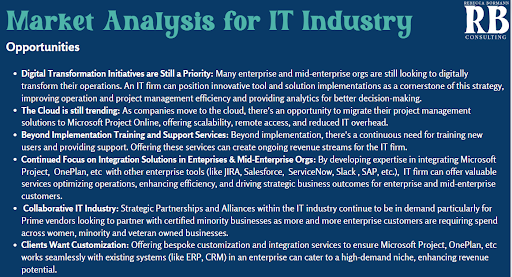
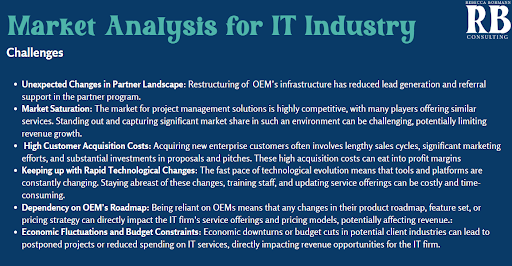
Identifying Target Markets and Customers
Identifying target markets and clients is crucial for effective business development. By clearly defining your ideal client profiles, you can tailor your marketing efforts to reach and engage the right audience. This involves considering factors such as demographics, psychographics, and buying behavior.
To identify your target markets, it’s helpful to start by analyzing your existing customer base and identifying common characteristics or preferences. Conduct market segmentation to divide the market into distinct groups based on shared characteristics.
Here’s an example of commonalities we found and how we categorized them for a training firm:
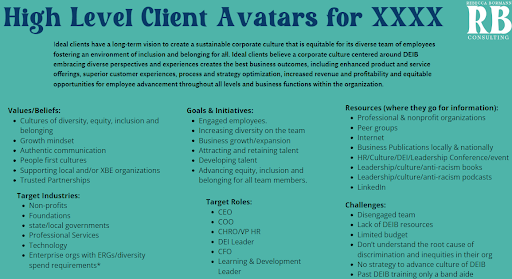
This segmentation allows you to develop several specific ideal client avatars and then leverage targeted marketing strategies that resonate with each avatar and maximize your reach.
Developing a Competitive Positioning Strategy
In a crowded marketplace, businesses need to differentiate themselves from competitors. Developing a competitive positioning strategy helps you define what sets your business apart and why customers should choose your products or services over alternatives.
Leverage Simon Sinek’s Golden Circle Theory to dig deeper defining your organization’s WHY.
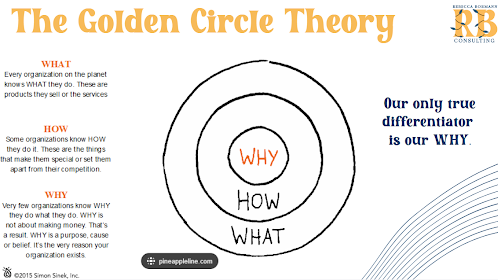
Try this framework to develop your company’s WHY, HOW & WHAT:
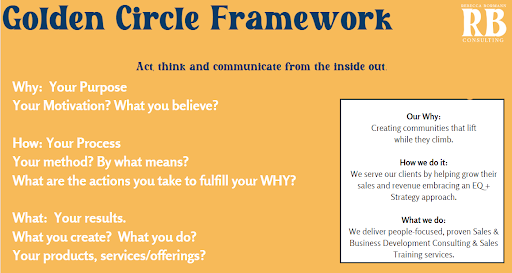
Conducting a competitive analysis is another critical step in your business development plan. Identify your competitors, their strengths and weaknesses, and their market positioning. This analysis allows you to uncover gaps in the market and identify opportunities for differentiation. Once you’ve determined what sets you apart, highlight your unique selling propositions and communicate them effectively through your branding, messaging, and customer experience
Another benefit of a competitive analysis is it provides you an opportunity to learn about the competition and potentially pinpoint opportunities for collaborative partnerships to offer more comprehensive solutions for both of your clients, mutually expanding one another’s portfolio of offerings and reach,
Creating a Sales and Marketing Strategy
A sales and marketing strategy is a crucial component of a business development plan and should be developed in tangent. It outlines how you will reach and engage your target audience, generate leads, and convert them into paying customers. This strategy should align with your overall business goals and leverage your competitive positioning.
When creating a sales and marketing strategy, consider the various channels and tactics available to reach your target audience. This may include digital marketing, social media advertising, content marketing, events, or partnerships. Develop a comprehensive plan that integrates these channels and tactics to create a cohesive and impactful customer journey.
Omni-Channel Sales & Marketing Strategies to be considered in your Business Development Plan:
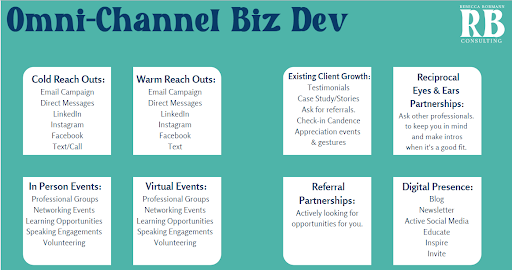
Implementing and Evaluating Your Business Development Plan
Implementing and evaluating your business development plan is key to ensuring its effectiveness and driving continuous improvement. Execution is crucial, as even the best plan is useless without proper implementation. Assign responsibilities, set clear timelines, and establish key performance indicators (KPIs) to measure progress and success.
Business Development Plans are not impactful when we set them and then forget them. This is a living plan that requires regular evaluation to assess its impact and make necessary adjustments when needed. Monitor KPIs, gather feedback from stakeholders, and stay updated on market trends. We recommend at least quarterly reviews of your Business Development Plan. It’s the ongoing evaluation that allows you to identify areas for improvement, capitalize on successful strategies, and adapt to changing market conditions.
Conclusion: The Power of a Strategic Business Development Plan
A well-executed business development plan provides numerous benefits, including clear direction and focus, identification of new opportunities, strong stakeholder relationships, and adaptability in a changing market. By implementing and evaluating your plan, you can continuously improve and accelerate your sales and impact.
Don't leave your growth to chance. Invest the time and effort in building a strategic business development plan, and unlock your full potential in today's competitive business landscape. With the right plan in place, you can navigate the challenges and seize the opportunities that come your way, propelling your business towards long-term success.